Dean &
Ginny's excellent adventures... Main
Adventure Page
Grand
Voyage--2012:
<<
Part 1 <<
Part 2 <<
Part 3 Part
4 Part
5 >>
Part 6 >>
|
|

As we sailed in, we took this photo of Olinda's hill, but it
provides only a small hint of the richness of
this World Heritage Site. We walked to a convenient road
going toward Olinda and caught a taxi.
|
|

As we continued to climb, we passed a convent and
then this empty lot with ruins and a gorgeous view.
Atop the first hill, the view from the
monastery is even better and in fact we could see our ship at the
dock down below. (It's in the center of the photo this side of the two tallest
buildings.)
|
We started at the tourist information center and
obtained a map and a suggested walking route, which was supposed to
take about 2 hours--starting with a climb.
<< On the
climb up, these silk cloths were displayed for sale.

|
|
|

We sat on a low wall and ate our oranges for lunch while enjoying the view
and the breezes.
|
This view over the convent is to the left of the one above.
Notice
the lighter and greener water above the reef. We particularly liked the
cloud formation.

|

The monastery was not a pretty building, but it
did offer these interesting roof lines.
|
|
We walked along a ridge from the monastery to this
church
with a huge plaza being used as a market, mostly for laces and fancy
costumes, which we presumed were for Carnival.

A dozen kids dressed in sequins and sneakers had
apparently been practicing for the big party.
This girl posed for us with little prompting. >>

We continued along the ridge and loved this display
of Carnival masks...

|
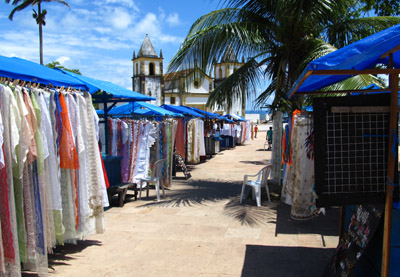

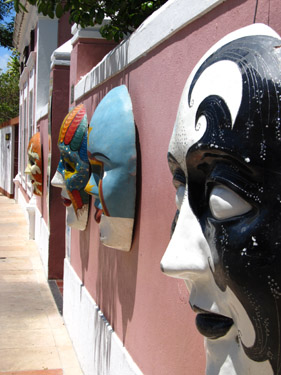
and this inviting Olinda Art and Grill. Then we
started to descend. |
 
Not sure of the significance of these vultures on the cross, but it's sure
to be some type of omen.
|
|






|
|


 

As we returned to the bottom of the hill, we found this very fast
checker match in the shade next to a mangrove-lined river. The
man moving his piece lost the game and a new challenger took on
the winner.
We flagged down a taxi to go straight to jail--the
one that's a market where we started our private tour. We caught a
shuttle bus back to the ship and called it a day.
Two days at sea and then on to Rio de
Janeiro--River of January. We'll be there for two days...
~ ~ ~
|
|

We
sailed into Rio first thing in the morning, so we got up early and
watched a beautiful sunrise. The ship's travel guide, Barbara, was to
narrate as we pulled into the harbor to let us know what we were
seeing. But as we got closer, the fog became so thick that the
ship started blowing its fog horn.
|
|

And behind Sugarloaf, the even higher peak with
the enormous Christ, the Redemer statue that can be seen from many
parts of the city. The 3rd hill sports a dozen tall towers for antenae.


A few oil platforms within the overall harbor mar the view not far from the city's main
waterfront. We also saw oil exploration ships and figured that oil
is king and tourists' sensibilities and the views from the city
are not as important.
|
Then... just as quickly, it lifted and we could easily
see Sugarloaf, the harbor's signature rock formation.



High rises crowd the waterfront and flat areas, while the favelas, slums housing the poorer
people of the city, rise up into
the hills in close proximity to the wealthy and business areas.
|
|
|
 
As we round each island, new views provide extreme contrasts between old
and new. An old church is dwarfed by twin tower skyscrapers and busy
airport for relatively small aircraft is built on reclaimed land right on the
waterfront.
|

Passengers lean on the port rail to take in the
city while Barbara explained what we were seeing. We thought this
green church out on a jetty was cool, but when we went to visit it
later that afternoon, we learned that it's a castle. More on that
later: our first item on our must-see list was the Botanical
Garden on the other side of town.
|


|
|


We'd read that the Uruguaina station was on Mister Two Steps
Road--the sign indicates that this name was suggested by Padre
Inacio Fernandes Fortes in 1732.
|
Dean's research on the city indicated that the
metro was easy to navigate and was reliable. So we found a
"Change House" to buy some reals, the local money, so we
could more easily get around and then we looked for the nearest
metro station, which was a few blocks from the port.

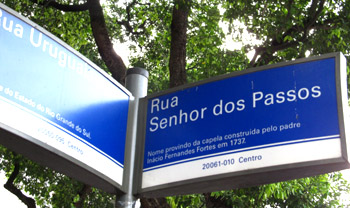
|
|

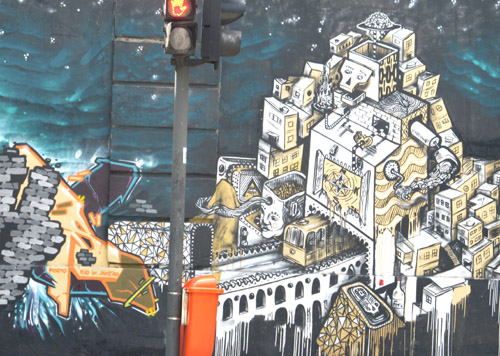

|
We paid for the ride on the Metro and a transfer to a bus to
the gardens. Standing room only on the train. We walked two blocks to get to the
garden. One the way we saw this inviting bronze street sculpture.
I sat at this man's desk to discuss business.

This highly graffittied wall was across from the gardens' main gate.

|
|
|

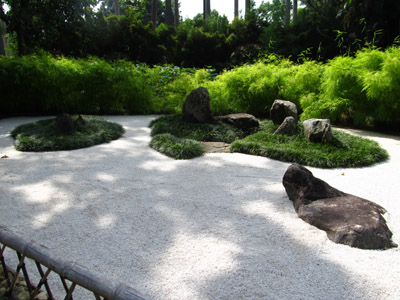
We started in the Japanese section where a sign proclaimed 100 years of
friendship between Japan and Brazil.
|
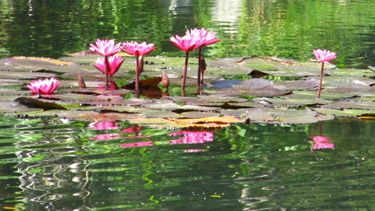


|
|


There were a large number of breadfruit trees with their fruits directly
attached to the trunk.
|
|
|
|

|
 |
|
After more than two hours
strolling through the grounds, we headed back to the ship. The
Metro was still crowded in the early afternoon, but we did find
a seat this time.
Dean's
Log: Days 12-14 |
|





